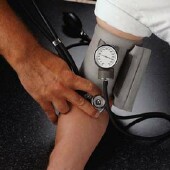
TUESDAY, May 25 (HealthDay News) — While the number of Americans with high blood pressure has not declined in recent years, researchers report that the good news is that more people with the condition have it under control.
High blood pressure, also known as hypertension, is a major risk factor for heart attack, stroke and other cardiovascular problems; it was considered such an important health issue that achieving a 50 percent control rate was made an official Healthy People 2010 goal.
That goal has been achieved, said Dr. Brent M. Egan, a professor of medicine and pharmacology at the Medical University of South Carolina and lead author of the report in the May 26 issue of the Journal of the American Medical Association. That report used data from a series of national health surveys running from 1988 to 2008.
“The good news is that blood pressure control has improved very substantially over the years,” Egan said. “It went from 27 percent of all hypertensives to 50 percent, with most of the progress since 2000. Awareness of high blood pressure improved from 69 to 81 percent, and the number of hypertensives on treatment improved from 54 percent to 72 percent.”
The bad news is that the number of Americans with high blood pressure has not gone down. “We’re doing a lousy job of trying to prevent it,” Egan said. An estimated 65 million Americans, about 29 percent of the population, now have high blood pressure, a far cry from the national goal of 16 percent.
The study defined high blood pressure as a reading of 140/90 or higher, self-reported use of blood pressure medications, or both. Control was defined as getting the reading below 140/90.
A breakdown by different groups shows that efforts at improving awareness of the dangers of high blood pressure and measures to control it must be carefully targeted, Egan said.
“With younger individuals, men and Hispanics, the emphasis needs to be placed on raising awareness and getting treatment,” he said. “For older individuals, African-Americans and women, while there are more people on treatment and awareness is high, the percentage under control is lower than average.”
Egan said he did the study because he has been working on hypertension awareness and control with 200 community-based medical practices in the southeastern United States, where high blood pressure is more common. “I thought we should have a good idea of what is happening nationally,” he said.
The survey found a slightly lower rate of hypertension control among blacks than the general population, but the difference is small enough so that it might be a matter of chance, Egan said. A recent study found an overall reduction of stroke incidence in the United States, but not in blacks.
Worries about high blood pressure have led to a proposal of a national program aimed at reducing the salt content of American foods, since high blood levels of sodium are known to raise blood pressure.
Reducing sodium intake is a good idea, Egan said, “but my own preference is to focus on diet quality. Eating more fruits and vegetables and whole foods reduces sodium intake.”
Preventive measures such as better diet, more physical activity and weight reduction are needed to bring hypertension under control, said Dr. Aram V. Chobanian, former dean of the Boston University Medical Center and president emeritus of Boston University, who wrote an accompanying editorial.
“There is very little evidence that lifestyle has improved in the United States, but in the long run that is where the greatest benefit is going to be,” Chobanian said. “Otherwise, as the population ages and the obesity epidemic increases, the prevalence of hypertension will increase.”
Changing the American lifestyle won’t be easy, he said. “It has to be a long-term process involving many different constituencies to do this,” Chobanian said. “It is hard work, and much more difficult than taking pills.”
More information
To learn about hypertension, and how to calculate your blood pressure, visit the American Heart Association.

